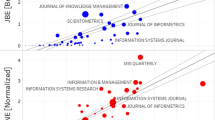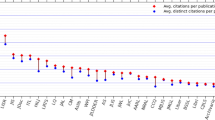Abstract
Journal impact indicators are useful measures to determine the relative importance of journals within a given discipline. By recasting the journal cross-citation matrix as a directed network, journals can be represented by nodes and journal-journal citations correspond to weighted directed links between nodes. In this form, it is possible to use graph-theoretic approaches to determine a ranking of nodes based on the structure of the links they are embedded in. Based on the Power-Weakness paradigm originally introduced by Ramanajucharyulu for ranking players in a tournament, we show how this idea can be modified under a bibliometric setting to find journals that contribute proportionate inbound and outbound citation flows within a homogeneous citation network to the extent that the power to influence and the weakness to be influenced by other journals are in near equal measure. We study two journal systems based on the Library and Information Sciences field based on a citation window in 2012 and another in 2018.

Similar content being viewed by others
Notes
For a directed graph with N nodes the maximum number of links is \(N(N-1)\). Hence, the network density for a directed graph with M links is \(D = M/[N(N-1)] \in [0,1]\). Sparse networks have a value of D closer to zero while dense networks will have D tending to 1.
References
Arunachalam, S., & Manorama, K. (1989). Are citation-based quantitative techniques adequate for measuring science on the periphery? Scientometrics, 15(5), 393–408.
Bavelas, A. (1950). Communication patterns in task-oriented groups. The Journal of the Acoustical Society of America, 22(6), 725–730.
Bergstrom, C. (2007). Eigenfactor: Measuring the value and prestige of scholarly journals. College Research Libraries News, 68(5), 314–316.
Bergstrom, C. T., & West, J. D. (2008). Assessing citations with the Eigenfactor metrics. Neurology, 71(23), 1850–1851.
Bordons, M., Fernández, M., & Gómez, I. (2002). Advantages and limitations in the use of impact factor measures for the assessment of research performance. Scientometrics, 53(2), 195–206.
Brin, S., & Page, L. (1998). The anatomy of a large-scale hypertextual web search engine. Computer Networks and ISDN Systems, 30(1), 107–117.
Cason, H., & Lubotsky, M. (1936). The influence and dependence of psychological journals on each other. Psychological Bulletin, 33(2), 95.
Daniel, R. S., & Louttit, C. M. (1953). Professional Problems in Psychology. Prentice-Hall, New York.
Dong, P., Loh, M., & Mondry, A. (2005). The “impact factor” revisited. Biomedical Digital Libraries, 2(7), 1–8.
Falagas, M. E., Kouranos, V. D., Arencibia-Jorge, R., & Karageorgopoulos, D. E. (2008). Comparison of scimago journal rank indicator with journal impact factor. The FASEB Journal, 22(8), 2623–2628.
Freeman, L. C. (1977). A set of measures of centrality based on betweenness. Sociometry, 40(1), 35–41.
Garfield, E. (1972). Citation Analysis as a Tool in Journal Evaluation. Science, 178(4060), 471–479.
Gazni, A., & Didegah, F. (2020). Journal self-citation trends in 1975–2017 and the effect on journal impact and article citations. Learned Publishing: Advance online publication. https://doi.org/10.1002/leap.1348
Gross, P. L., & Gross, E. M. (1927). College libraries and chemical education. Science, 66(1713), 385–389.
Hagberg, A. A., Schult, D. A., & Swart, P. J. (2008). Exploring network structure, dynamics, and function using NetworkX. In G. Varoquaux, T. Vaught, & J. Millman (Eds.), Proceedings of the 7th Python in Science Conference (SciPy2008, pp. 11–15). Pasadena, CA USA.
Harris, C. R., Millman, K. J., van der Walt, S. J., Gommers, R., Virtanen, P., Cournapeau, D., Wieser, E., Taylor, J., Berg, S., Smith, N. J., Kern, R., Picus, M., Hoyer, S., van Kerkwijk, M. H., Brett, M., Haldane, A., & del R’ıo, J. F., Wiebe, M., Peterson, P., G’erard-Marchant, P., Sheppard, K., Reddy, T., Weckesser, W., Abbasi, H., Gohlke, C., & Oliphant, T. E. . (2020). Array programming with NumPy. Nature, 585, 357–362.
Hubbell, C. H. (1965). An input-output approach to clique identification. Sociometry, 28(4), 377–399.
Kessler, M. M. (1965). Some statistical properties of citations in the literature of physics. In M. E. Stevens, V. E. Giuliano, & L. B. Heilprin (Eds.), Statistical Association Methods in Mechanized Documentation (Symposium Proceedings, pp. 193–198). National Bureau of Standards, Washington.
Lathabai, H. H., Prabhakaran, T., & Changat, M. (2017). Contextual productivity assessment of authors and journals: A network scientometric approach. Scientometrics, 110(2), 711–737.
Leontief, W. W. (1941). The Structure of the American Economy, 1919–1929. Cambridge: Harvard University Press.
Leydesdorff, L. (2009). How are new citation-based journal indicators adding to the bibliometric toolbox? Journal of the American Society for Information Science and Technology, 60(7), 1327–1336.
Leydesdorff, L., de Nooy, W., & Bornmann, L. (2017). The Power-weakness Ratios (PWR) as a Journal Indicator: Testing the “Tournaments” Metaphor in Citation Impact Studies. Journal of Data and Information Science, 1(3), 6–26.
Moore, W. J. (1972). The relative quality of economics journals: a suggested rating system. Economic Inquiry, 10(2), 156.
Narin, F., Carpenter, M., & Berlt, N. C. (1972). Interrelationships of scientific journals. Journal of the American Society for Information Science, 23(5), 323–331.
Pedregosa, F., Varoquaux, G., Gramfort, A., Michel, V., Thirion, B., Grisel, O., Blondel, M., Prettenhofer, P., Weiss, R., Dubourg, V., Vanderplas, J., Passos, A., & Cournapeau, D. (2011). Scikit-learn: Machine Learning in Python. The Journal of Machine Learning Research, 12, 2825–2830.
Pinski, G., & Narin, F. (1976). Citation influence for journal aggregates of scientific publications: Theory, with application to the literature of physics. Information Processing Management, 12(5), 297–312.
Prathap, G. (2019). The Pinski-Narin influence weight and the Ramanujacharyulu power-weakness ratio indicators revisited. Scientometrics, 119(2), 1173–1185.
Prathap, G. (2020). A tournament metaphor for dominance hierarchy. Current Science, 118(9), 1432–1436.
Prathap, G., & Nishy, P. (2016). An alternative size-independent journal performance indicator for science on the periphery. Current Science, 111(11), 1802–1810.
Prathap, G., Nishy, P., & Savithri, S. (2016). On the orthogonality of indicators of journal performance. Current Science, 111(5), 876–881.
Ramanujacharyulu, C. (1964). Analysis of preferential experiments. Psychometrika, 29(3), 257–261.
Salancik, G. R. (1986). An index of subgroup influence in dependency networks. Administrative Science Quarterly, 31(2), 194–211.
Todorov, R., & Glänzel, W. (1988). Journal citation measures: A concise review. Journal of Information Science, 14(1), 47–56.
Todeschini, R., Grisoni, F., & Nembri, S. (2015). Weighted Power-Weakness Ratio for multi-criteria decision making. Chemometrics and Intelligent Laboratory Systems, 146, 329–336.
Todeschini, R., Grisoni, F., & Ballabio, D. (2019). Deep Ranking Analysis by Power Eigenvectors (DRAPE): A wizard for ranking and multi-criteria decision making. Chemometrics and Intelligent Laboratory Systems, 191, 129–137.
Valsecchi, C., Ballabio, D., Consonni, V., & Todeschini, R. (2020). Deep Ranking Analysis by Power Eigenvectors (DRAPE): a polypharmacology case study. Chemometrics and Intelligent Laboratory Systems, 203, 104001.
Van Leeuwen, T., Moed, H., Tijssen, R., Visser, M., & Van Raan, A. (2001). Language biases in the coverage of the science citation index and its consequencesfor international comparisons of national research performance. Scientometrics, 51(1), 335–346.
Velho, L. (1986). The “meaning” of citation in the context of a scientifically peripheral country. Scientometrics, 9, 71–89.
Virtanen, P., Gommers, R., Oliphant, T. E., Haberland, M., Reddy, T., Cournapeau, D., Burovski, E., Peterson, P., Weckesser, W., Bright, J., van der Walt, S. J., Brett, M., Wilson, J., Millman, K. J., Mayorov, N., Nelson, A. R. J., Jones, E., Kern, R., Larson, E., Carey, C. J., Polat, I., Feng, Y., Moore, E. W., VanderPlas, J., Laxalde, D., Perktold, J., Cimrman, R., Henriksen, I., Quintero, E. A., Harris, C. R., Archibald, A. M., Ribeiro, A. H., Pedregosa, F., van Mulbregt, P., & SciPy 1.0 Contributors (2020). SciPy 1.0: fundamental algorithms for scientific computing in Python. Nature Methods, 17, 261–272.
West, J. D., Bergstrom, T. C., & Bergstrom, C. T. (2010). The Eigenfactor Metrics™: A network approach to assessing scholarly journals. College & Research Libraries, 71(3), 236–244.
Xhignesse, L. V., & Osgood, C. E. (1967). Bibliographical citation characteristics of the psychological journal network in 1950 and in 1960. American Psychologist, 22(9), 778–791.
Yan, E., & Ding, Y. (2011). The effects of dangling nodes on citation networks. In Proceedings of the 13th International Conference on Scientometrics and Informetrics, July 4-8, 2011, Durban, South Africa.
Zhang, L., Glänzel, W., & Liang, L. (2009). Tracing the role of individual journals in a cross-citation network based on different indicators. Scientometrics, 81(3), 821–838.
Zhu, X., Turney, P., Lemire, D., & Vellino, A. (2015). Measuring academic influence: Not all citations are equal. Journal of the Association for Information Science and Technology, 66(2), 408–427.
Author information
Authors and Affiliations
Corresponding author
Rights and permissions
About this article
Cite this article
Ujum, E.A., Kumar, S., Ratnavelu, K. et al. A new journal power-weakness ratio to measure journal impact. Scientometrics 126, 9051–9068 (2021). https://doi.org/10.1007/s11192-021-04132-5
Received:
Accepted:
Published:
Issue Date:
DOI: https://doi.org/10.1007/s11192-021-04132-5




